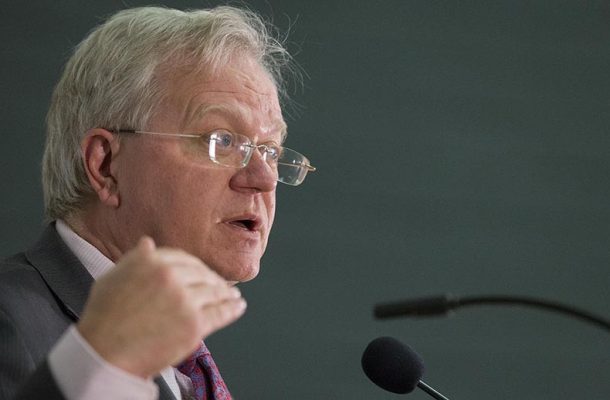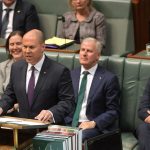The view from the top

Singapore is one of the liveliest and most vibrant and connected places in the world and standing in this global crossroads for finance, trade, diplomacy and education, offers a good opportunity to think about the world around us as it presents itself in 2018. We certainly live in the apocryphal “interesting times”.
This well-worn phrase has been said many times before – but not all times are equally interesting…
Will these years look like the rise of Sumer, the age of the Egyptian pharaohs, Athenian Greece, the glories of Rome, the Han dynasty, the Renaissance, the Industrial Revolution?
Or, less happily, will they look like the 3 Kingdoms War, The Fall of Rome, Ottoman Wars, WWI and WWII?
Only time will tell.
But we are entering what seems to be, for me, the most interesting time for humanity since WWII and the early Cold War. The pace of technological change is staggering, and this is accompanied by a new social and political uncertainty, and global instabilities that have not been present in my lifetime.
But we are also lucky enough to live in a time of hope and progress. Human longevity has moved quickly up to greater than 71 years.
Where the fraction of the world living in extreme poverty is dropping precipitously, from 35 per cent in 1990 to 10.7 per cent in 2013, according to the World Bank.
We live in a time where every human on planet Earth will soon be able to engage with the rest of the world – digitally, by mass transit, by trade. There will be 53 per cent internet penetration according to 2018 ‘We Are Social’ analysis.
And where we are ever more able to precisely manipulate life through our understanding of the genome.
We have developed the beginnings of artificial intelligence, recording of data on unimaginable scales, and new technologies that in theory should do much of the hard work we all do – and give us more leisure time.
These are the rewards of the collective ingenuity of the human race.
But humanity is also affecting our planet – we live in the Anthropocene age:
Where our use of the Earth’s resources is not sustainable over the current human life-time;
where the rapid rise of prosperity for all – especially amongst some of the haves in developed economies – has slowed for the first time since WWII;
where democracies struggle against the rise of populism and the abundance of information – some true and some false; while autocracies are able to double down with AI and data to increase their powers through the control of information; where everyone finally has a voice – but it is hard to hear what is important amid the deafening collective noise.
So, in these times, humanity faces a choice.
Either we choose to power-through the Anthropocene with knowledge, technology, and human organisation creating a world that is able to thrive on Earth in a sustainable prosperity…
Or we see ourselves fall into conflict, where the haves and have nots fight over the finite resources of Earth. Where everyone finds themselves less prosperous, less secure, and ultimately, less happy.
Facing the challenges ahead
To navigate through this interesting era – requires a multi-decade look at the challenges we face and the solutions we might develop.
These solutions will involve ideas not yet had, and technologies not yet invented. They will require marrying social sciences with technology. And they will need to bring along and include the entire world.
We, in the university sector, will be – in my opinion – the most critical of all institutions, in finding the pathways to a prosperous and sustainable global future:
We will educate those – young and old – who will be productive in a rapidly changing world.
We will undertake much of the research that underpins the technological development required to cope with our demands on the planet.
We will be the place where much of the thinking emerges on how to marry technology with human behaviour; and
We will be the places most open to contemplating whatever changes to the world-order are going to be required to keep the peace as change occurs.
In other words – we must lead if we are to serve humanity.
This isn’t something we, the university sector, can wait for permission to do. It has been the role of universities for almost a millenium, to challenge orthodoxy and think big. Now is our chance to step up – do things differently – and lead the way.
The opportunity to help steer my university to take on this challenge was the key motivation for me to leave my very comfortable and largely uncomplicated lifestyle as Nobel Laureate, to become Vice Chancellor.
I am going to focus on my thinking about how to make universities have impact – and yes this involves transforming society with our research. But it is universities’ intertwined missions and values that make us different and I believe are essential for research to have its transformative power. These interactions are worth reflecting upon, and I will do so later – because they are often taken for granted, and I believe are likely to come under threat.
At the core of universities’ value to society, is our increase in the stock of knowledge. Not just STEM, not just things which have a potential path to translation – it is the whole of the academic enterprise. It is from this stock of knowledge that new ideas, revolutions in technology, and societal transformation emerge.
Even in the most friendly of societies to universities, I still see scepticism emerge on a regular basis – where every piece of academia should be justified by its direct utility to society – with filters suiting the political mood of the day applied on each item.
This unfiltered pursuit of knowledge is the building block of all that we do. And it is essential for us to fight all attempts that seek to hinder its pursuit, if we are going to be able to advance prosperity for all on a global and sustainable scale.
But our millennium of history does not mean that universities should not change, so let me give some examples of how at ANU we are trying to break out of business as usual.
Innovation at the ANU
ANU, like the vast majority of universities around the world, finds its relationship with business on tenuous ground. We don’t understand each other very well – business finds it difficult to identify if we have knowledge of interest to them – they see that most of our research is too abstract for its immediate needs, and our staff much more intent at working on their next Nature paper or manuscript, than being a highly responsive partner.
I do not expect everyone – or even most of my staff – to work successfully with business, but it is important that we have people who can successfully translate between academia and business – and it is certainly becoming expected that our students can translate their education into something tangible for their employers.
To this end – we have created a series of innovation institutes lead by entrepeneurial staff members who have track records at navigating between industry and academia. These staff and their institutes are meant to provide a template for the rest of the community on how the industry/academic interface works – so the rest of us can have some guidance and confidence of what to do when an opportunity presents itself.
These innovation institutes and their founders are introducing a new culture to my university – a culture of innovation that we are supporting with lots of carrots for those who wish to pursue it – which I hope will lead to a greater migration of tangible outcomes from the knowledge within the University.
The innovation institutes themselves are not meant to be business as usual technology – that can occur outside the University much more efficiently – rather they are working in areas at the leading edge of technology – at a stage where businesses are not prepared to typically invest on their own.
For example, we have created a new academic hub – the ground-breaking 3A Innovation Institute, (Autonomy, Agency and Assurance) where we are creating a new applied science to manage the machines.
Under the directorship of Intel Senior Fellow (and former Vice President), Professor Genevieve Bell, the 3A Institute is doing nothing less than carving out a whole new disciplinary field aimed at helping us optimally design systems that work in the emerging and complex area of artificial intelligence, big data, cyber-physical systems, and their interactions with humanity.
Our intention is to influence and shape emerging technologies early on to reflect our humanity, culture and values – and make sure these advances bring prosperity, not chaos to the world.
Genevieve is bringing the whole culture of industry to the way the University works – jump-starting a Master’s program which involves creating itself as part of the program.
Another innovation institute has brought the inventor of the Nano-patch (a needleless vaccine delivery system) – Mark Kendall, to ANU earlier this year. He is creating a platform around wearable technologies that can continuously measure what is happening inside you, without needles or discomfort.
We are co-investing in a new company where research in the University can be quickly translated into technology that can be brought to market.
To change culture, we have challenged our staff to look at how we can take the deep expertise of the University and apply it for the public good – and have provided up to $10 million for each idea.
Just last week, four interdisciplinary teams, which included many of our most prominent researchers, young and old, pitched their ideas our staff. A program around creating a zero-carbon energy solution for South-East Asia emerged as winner.
They are working with a major industrial partner to create a multi-billion dollar industry of exporting cheap and reliable renewable energy from Northern Australia across the Timor-gap to Timor Leste and Indonesia. A remarkable team that includes our energy experts in physics and engineering, but also our economists, environmental scientists, our Indigenous scholars, and our humanities experts in South-East Asia.
It has brought together the University in a way that I could have only dreamed of. These are just a few of the new ideas we are pursuing, but give you a flavour of our approach.
I am hoping these programs will encourage more of my staff and students to take their knowledge out of the University and create new businesses, or invigorate existing ones. So we have created a whole ecosystem from proof of concept to late stage capital to help our ideas blossom. My goal is make sure any good idea of the University is as useful for society as possible.
We are also trying to better understand what the needs are for existing businesses, and are supporting SMEs by subsidising their access to our equipment and resources where that can be of benefit. We take a highly flexible approach in our dealings, tailored to each person or company.
While there are reasons to protect the University’s IP – and royalties will emerge from this – I take my cue from Stanford and MIT that it is even more lucrative to help make people and companies do well – so that they really are able then to give back. For example, in 2016-17 Stanford received US$45.4 million dollars in royalty income from 808 technologies – but it pales when compared to the US$1.13 billion they received in philanthropy!
Overcoming the social barriers to prosperity
Many of the barriers for our future prosperity are not technology driven – they are societal. The political institutions in democracies around the world are finding it very difficult to have healthy debates around fundamental issues affecting our societies to enable sensible policy responses. Universities are a safe place where the conversations that societies need to have happen, can happen.
For example, Australia has very specific issues around members of our Aboriginal and Torres Strait Islander people. In addition to profoundly different health outcomes – there is an unaddressed lack of recognition and self-determination as required by UN-treaties which Australia has signed, and enduring racist language in our constitution.
While the vast majority of Australians want these issues addressed, there is great uncertainty of how to do it within political circles. To help advance the issue, we ran a First Nations’ governance forum in July where we brought people from around the world looking at First Nations’ recognition and self-determination, followed up with a round-table in Parliament that has helped inform a joint select committee of Parliament on the issue.
There are a whole range of places where universities can be the circuit breakers in controversial spaces. Where political leaders are unable to go, universities can and we should. Inequality, security, climate change, nuclear proliferation, mass migration, international relations: the biggest issues we face, all bogged down in the political processes and crying out for clear, evidence-informed solutions.
This is how to build up nations- and if we can get the political system unclogged – get conversations and momentum on addressing the big policy issues – we will remove many of the impediments to productivity which ultimately drive our economies and bring prosperity to all.
But to have these conversations, universities must remain places where ideas really can be freely expressed – even in this polarised world – across cultures, politics, and age. And while these conversations can be tough – and we need to remain supportive of those who feel aggrieved – we must allow scholarly conversations on controversial issues.
And this is an emerging threat to our institutions. Universities’ autonomy and integrity are being continually tested, as is academic freedom on our campuses. This is not a right or left thing – it is both. And it is essential for universities to resolutely stick to these fundamental principles that insulate them from being corrupted by the politics and biases of the day.
To help increase our positive outcomes, we have realised that we need to have a sophisticated discussion on what success looks like:
It’s not just Nature or Science papers, it’s not just how much you publish.
It is ultimately your impact – how you have changed how people think and how people act:
whether it be your students and their outcomes, the technology you have brought to market, the policies you have helped create, the discoveries you have made.
They are all part of the same continuum – and my approach is to let each academic have the freedom to have impact over the spectrum, however they see best.
This is hard to measure within a single frame-work, but we are working on it – and I am encouraged because it is pretty obvious which of our staff are having impact across the spectrum, even if hard to quantify with a single number.
For me – it is realising that mediocrity is the enemy; Business as usual has its place, but it should be surrounded by bold thinking, risk taking, and pursuit of new ideas; If we are going to solve the world’s problems – we need to encourage our staff to be risk takers – long-term thinkers – and not just always play it safe to get the next grant.
But it also means we need to find a way to support our staff when they fail – or when results are slow because the problem is hard. We are looking at safety nets, seed funding, and income contingent loans as part of the mix to support researchers to take risks.
Universities are for students as well as research
I haven’t yet talked much about our students.
When I talk to government or business, the thing they are most excited about in my University is not our research. It is our students. They are our most potent ambassadors. They take our knowledge and disperse across the world, embedding it into business, into government, and into civil society at a scale well beyond anything else we do. Yet we underplay this crucial role of research universities – our teaching.
However, I believe the Humboldtian tradition where education is informed by research is under-threat – many universities are splitting education from research – and I suspect it is university rankings that are partially behind driving this behaviour.
The basic idea is simple; massify education using non-research active faculty who are very good teachers; cross subsidise research-only staff with the profits of teaching, and in theory – you get students, who are happy and inspired, and happy researchers who don’t teach. But the teaching/research nexus is broken.
This begs the question, “Why should those students be taught at a research university at all?” It is much more efficient to have them taught at teaching only higher-education institutions (possibly commercial), where costs can be driven down.
This is a dangerous cycle, because in its first iteration, students are being taught by a generation of teachers whose higher education was taught by research-active staff. In the second generation, the students are completely decoupled from the research of the day. And while elite institutions may feel immune from such an issue – they too will be affected.
The whole university environment is one of cross-fertilisation and interdependency, and if a huge section of the university ecosystem drops out, the research universities that remain will be isolated from the talent and ideas that currently emerge across the system.
For my part, I am trying to make sure that we think deeply about how research informs the teaching of our graduates – and we don’t just take it for granted. Making sure that my entire research staff teach, and that they are supported in their teaching so that it is effective. That every student has research opportunities as part of their degrees.
We are training next generation of leaders – our students – who we need to treat as intellectual partners – not parcels on an assembly line.
Another threat, research universities, especially elite ones, have had their social license come under threat over the past few years – not so much in Australia, but certainly in the UK and the USA. The rise of populism has created segments of society that see universities as the enemy.
Not just of no value to them, but working against what they see as their best interests. We are working very hard at ANU to get in front of this issue in Australia by changing the way we engage with communities across Australia, including how we admit our students.
Rather than a nebulous admissions process, we are targeting the best and brightest across each school in the country. My hope is that communities will rally around these students’ opportunities, and these students will become our ambassadors.
While we do a lot of work that has positive impacts in communities across our country, we can better engage with these communities to explain what we are doing, and plan together joint projects.
We are here at the time of the release of the Times Higher Education Rankings. Rankings are looked at by our students, our future students, our staff and our societies for clues as to how successfully universities are fulfilling their missions.
But despite their visibility, university leaders cannot be slaves to the rankings and their evolving methodologies. Rather, we must have the confidence to do the best we can at our missions and hope the rankings sensibly reflect our successes and failures – noting each of our idiosyncrasies.
More than anything, universities must place themselves at the epicentre of society, and guide the transformations that must occur if humanity is to achieve a globally sustainable future. The alternative is not worth contemplating.
Professor Brian Schmidt, Vice Chancellor of the Australian National University, delivered this keynote address to the Times Higher Education World Academic Summit in Singapore.
Professor Brian Schmidt was appointed Vice-Chancellor and President of the Australian National University in January 2016. Winner of the 2011 Nobel Prize in Physics, he was previously an astrophysicist at the Mount Stromlo Observatory.













